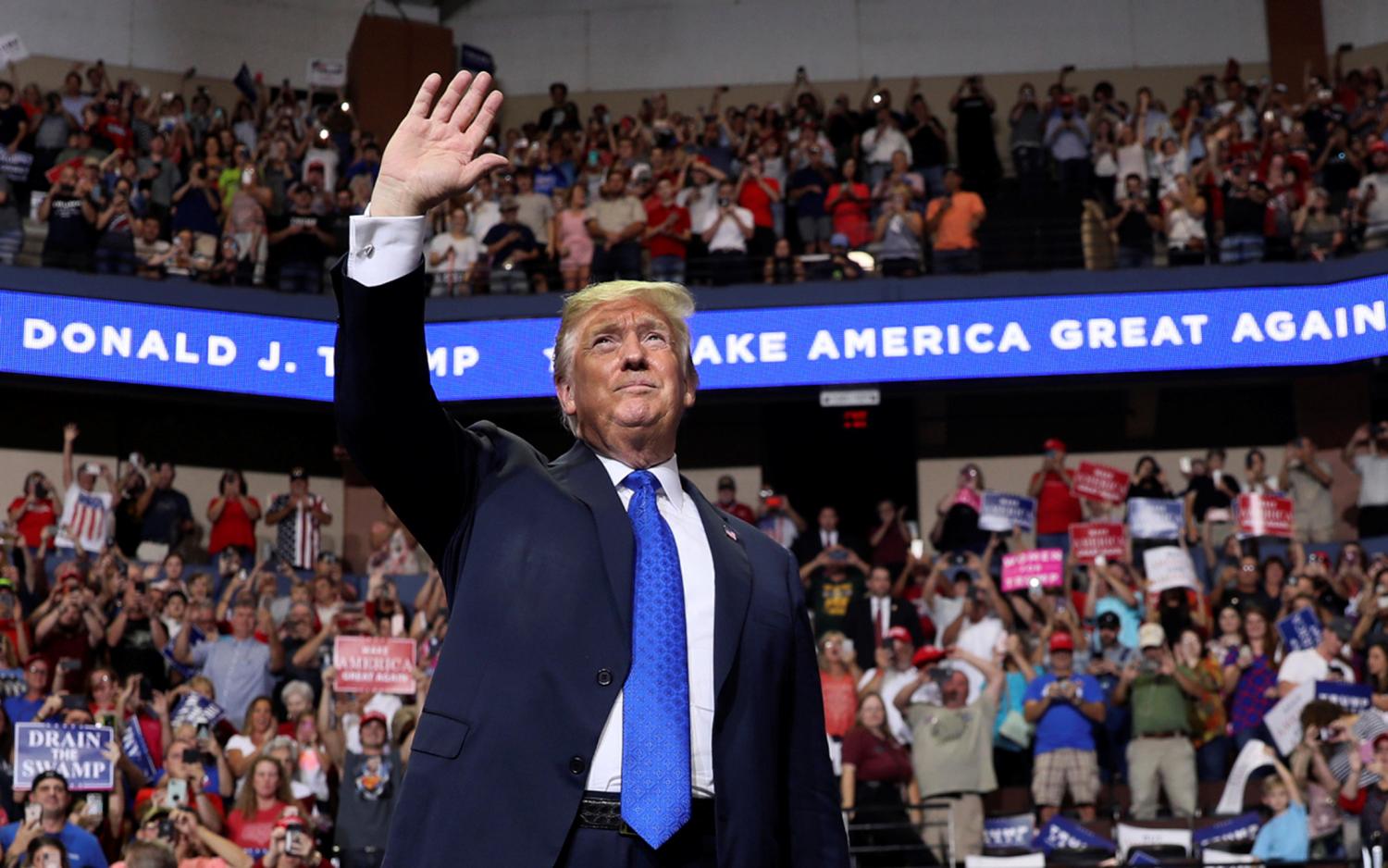The following is the third section of “Political polarization and congressional candidates in the 2018 primaries,” a report from The Primaries Project at Brookings.
The 2016 presidential primaries in both parties were powerful reminders of just how important factions are in defining political parties. Writing in “Engines of Change: Party Factions in American Politics, 1868-2010” (2012), Daniel DiSalvo states:
Given the public’s limited political knowledge, factions retain a good deal of room to maneuver in order to shape their party’s brand and convert their views into public policy, even if factions’ views are well to the left or right of centrist voters. … It is factions that often undertake synchronized action to refine the party, forcing the more dispersed and amorphous elements to respond.
Congressional primaries allow us to view the various factions that compose each political party. By focusing on the major factions that make up both parties, we can see the divisions within parties and see how they might shed light on the divisions between parties. Starting with the Tea Party movement in 2010 and running through the insurgent presidential campaign of Bernie Sanders in 2016, both political parties have had serious intra-party divisions. On the Republican side, these divisions have kept their party in a constant state of tension between rank-and-file Republicans and the far-right Republicans who constituted first the Tea Party Caucus and then the Freedom Caucus. On the Democratic side, the left-wing activism inspired by the Sanders campaign has the potential to turn any future Democratic majorities into mirror images of the problems that have plagued the Republican majority. For instance, a large number of far-left members of Congress could keep the leadership from entering into compromises on big issues like budget and entitlements.
To try to get a better understanding of the various factions that arise in congressional primaries, we looked at how congressional candidates described themselves in terms of the most common intraparty groups. Looking at candidate campaign websites, we assigned Republicans to one of four categories: Business/Establishment, Conservative, Tea Party, or Libertarian. Democrats were sorted into one of three categories: Progressive, Establishment, or Moderate. For candidates who did not provide enough information for us to categorize them (or for candidates who had confusing or complicated factional identities), we simply coded them as “Other.”
To assign the major party candidates to these categories, we used a four-step assignment logic (i.e., the process would only move to step two if step one did not render a party category classification, etc.). First, the candidate websites were examined for any personal identification to one of these categories. Examples of self-identification were sometimes explicit (e.g., “conservative” might have been in the candidate’s slogan) but also sometimes implicit (e.g., a candidate mentioning how her business experience led her to politics). Whenever there were competing party categories (e.g., one can imagine a candidate who might be placed in either the Conservative Republican or Tea Party Republican categories), the following party category ranking system was in place: Tea Party, Libertarian, Conservative, and then Business/Establishment; Progressive, Moderate, and then Establishment. This ranking system allowed the coding scheme to prioritize assignment to more narrow groups.
Congressional primaries allow us to view the various factions that compose each political party. By focusing on the major factions that make up both parties, we can see the divisions within parties and see how they might shed light on the divisions between parties.
Second, after personal identification, incumbent candidates were placed in a category according to caucus memberships. For incumbent Democrats, these were the Progressive Caucus, the (former) Moderate Democrats Working Group, and the Blue Dog Coalition. If Republican incumbents were members of the (former) Tea Party caucus, they were coded as such. Additionally, information about minor party affiliations of major party candidates in New York’s system of fusion voting was also used for coding party categories. For further information, please consult the Appendix.
Third, endorsements listed on campaign websites also informed party categories. If a candidate listed an endorsement from Tea Party Express, that candidate was counted as a Tea Party Republican. If a different candidate listed an endorsement by the U.S. Chamber of Commerce, then that candidate was categorized as a Business/Establishment Republican. If a candidate listed an endorsement from Bernie Sanders himself or from one of the groups created with momentum from the Bernie campaign, such as Our Revolution or Justice for All, they were coded as Progressive. In the case of multiple endorsements across party categories, endorsements’ placement on the website and other contextual factors were taken into consideration. However, endorsements not listed on a candidate’s website were not considered.
Fourth, in cases of candidates failing to meet any of the above party category criteria, candidates were categorized according to their issue positions. If, however, there was still confusion (or not enough information conveyed by a candidate’s issue positions), the candidate was simply coded as Other.
Figure 5 and Figure 6 show the breakdown of factions within each party’s slate of candidates for the House of Representatives. Figure 5 shows that, compared to 2014 and 2016, there are many more Progressive candidates and slightly fewer moderates on the Democratic side in 2018. The increase in self-identified Progressive candidates reflects the power of Bernie Sanders’s candidacy and the determination of his voters to keep his movement going.
On the Republican side, we see the continued disappearance of self-identified “Tea Party” Republicans, which began between 2014 and 2016, as indicated in Figure 6. But between those years, the most Republican congressional candidates identify simply as Conservative.
We next calculated how each faction within each party performed in their primaries. We chose to look only at non-incumbents, because incumbency is such a powerful factor in these elections—that is, incumbents almost always win. On the Democratic side, there were slightly more Establishment candidates than Progressive candidates and Establishment candidates won more often. As Table 6 below shows, the Establishment candidates won their Democratic primaries 35.0 percent of the time, while the Progressives won their primaries 26.6 percent of the time.
Table 6: Primary win/loss rates by party category among non-incumbent House Democrats, 2018
| Win | Lose | |
| Establishment Democrats | 140 (35.0%) |
260 (65.0%) |
| Progressive Democrats |
101 (26.6%) |
278 (73.4%) |
On the Republican side, the Establishment candidates did even better, winning their primaries 40 percent of the time compared to 24.8 percent of the time for Conservative candidates, as indicated in Table 7.
Table 7: Primary win/loss rates by party category among non-incumbent House Republicans, 2018
| Win | Lose | |
| Business/Establishment Republicans | 76 (40.4%) |
112 (59.6%) |
| Conservative Republicans |
79 (24.8%) |
240 (75.2%) |
| Libertarian Republicans |
1 (20.0%) |
4 (80.0%) |
| Tea Party Republicans |
7 (35.0%) |
13 (65.0%) |
The greater success rate of Establishment candidates in both political parties is probably due to several factors. Candidates who are coded as Establishment candidates have often held another elected office such as Mayor or County Commissioner. This means that they are likely to have higher name recognition, they have their own record to run on, and they are less reliant on ideology as a means of courting voters in a primary. The win/loss record of Establishment challengers in both parties shows that, even in an era of intra-party polarization, candidate quality and experience still matters.1
The success of Establishment candidates also calls into question the somewhat breathless journalistic coverage of the 2018 campaigns. Two popular narratives took hold this year. On the Republican side, the story line was how the GOP had become the party of Trump. On the Democratic side, the story was that Bernie Sanders was pulling the party to the left. However, the win/loss ratios of the different factions in each party contradict the notion that the two political parties have become wholly-owned subsidiaries of their more extreme wings.
The press also made much of the fact that President Trump broke with tradition by endorsing candidates during the primary season—and that many of them won their races.2 Most, however, were also the picks of the Republican establishment. As Table 7 illustrates, Republican Business/Establishment candidates have a much better success rate than the more ideological Conservatives.
Another way to ascertain the extent to which the Republican Party has become Trump’s party is to look at how Republican candidates talked about him. In our review of Republican candidates, we coded everyone running for whether they mentioned Trump on their campaign websites and, if so, how they mentioned him. Table 8 shows how Republican challengers talked about President Trump on their websites. It is not surprising that few were negative and that most were positive. What is surprising is that nearly half of the Republican challengers made no mention of President Trump at all—a finding that provides some contrary evidence to the narrative that Trump has taken over the Republican Party.
Table 8: Primary win/loss rates among non-incumbent House Republicans mentioning President Trump, 2018
| Positive | Neutral | Complicated | Negative | No mention | |
| Primary winners |
64 (32.5%) |
16 (8.1%) |
8 (4.1%) |
3 (1.5%) |
106 (53.8%) |
| Primary losers |
191 (39.6%) |
15 (3.1%) |
10 (2.1%) |
12 (2.5%) |
254 (52.7%) |
And on the Democratic side, the steady success of Establishment candidates calls into question whether the Democrats are being pulled to the left. For every well-known Progressive upset—such as the victories of Alexandria Ocasio-Cortez in New York or Ayanna Pressley in Massachusetts—there are victories of more conventional Democratic candidates. Democrats like Sen. Tom Carper (Del.) and Rep. Betty McCollum (Minn.) both easily defeated Progressive challengers. In spite of the fact that the press was constantly on the lookout for signs that Bernie Sanders was taking over the Democratic Party, he was barely mentioned by the primary candidates, as Figure 8 illustrates.
Moreover, in 2018, Democratic leaders paid particular attention to the primaries for those seats that were most likely to flip from Republican to Democrat. The Democratic Congressional Campaign Committee (DCCC) was aggressive about injecting itself in primaries to ensure its preferred candidates were on the ballot. This provoked a fair amount of complaints from the left wing of the party. In the end, however, the DCCC-endorsed candidates won 39 of the 41 primaries in which they intervened.34
The aggressiveness of the DCCC may pay off in November. The side-by-side display in Figure 9 shows the two groups of Democratic primary winners by the PVI of the districts where they will compete in November. (PVI stands for Partisan Voting Index, a measure created by Charlie Cook that indicates how strongly a district leans toward Democrats or Republicans.) Democratic non-incumbents have the best chance of winning in districts that are Democrat-leaning or Even. Focusing on the slightly Republican districts (Even to R+10), there are more Establishment candidates than Progressive candidates. When looking at the more solid Republican districts (greater than R+10), however, there is a relatively large number of Progressive nominees. In these districts, it may be more difficult for any Democrat to win—unless the blue wave turns into a blue tsunami.
What The Primaries Project tells us is that while the internal factions within each political party are strong and significant, the situation within each party is more nuanced than the headlines would have you believe. To understand better what this may mean for the next Congress, we now turn to data on what the primary candidates have been saying on the campaign trail.
Continue to the next section, “What are the candidates talking about, and what are they not talking about?“
-
Footnotes
- See, for instance, Michael R. Kulisheck and Jeffery J. Mondak, “Candidate quality and the congressional vote: A causal connection?” Electoral Studies, Volume 15, Issue 2, May 1996 – Pages 237-253.
- See, for instance, Audry Carlsen and Isabella Grullon Paz, “Trump’s Endorsements: The Loyalists, Rising Stars and Safe Bets He’s Picked,” The New York Times, September 10, 2018. Accessed at: https://www.nytimes.com/interactive/2018/08/14/us/elections/trump-endorsements-midterms.html.
- James Hohmann, “The daily 202: New York primary results challenges the crystallizing 2018 narrative,” The Washington Post, September 14, 2018. Accessed at: https://www.washingtonpost.com/news/powerpost/paloma/daily-202/2018/09/14/daily-202-new-york-primary-results-challenge-the-crystallizing-2018-narrative/5b9b14491b326b47ec9595d4/?noredirect=on&utm_term=.08293b3567aa.
- Elaine Kamarck, “Actually National Democrats Should Interfere in Primaries,” The New York Times, May 3, 2018. Accessed at: https://www.nytimes.com/2018/05/03/opinion/dccc-democratic-primaries-interference.html.





